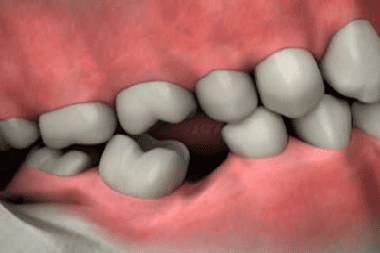Dentistry >>>> Why are teeth shifting?
Why are teeth shifting?

The teeth are held in the jawbone in the periodontal gap: due to the periodontium (ligamentous apparatus) and bone tissue (alveolar plate formed by various cells). The periodontium is actually a connective tissue that has elasticity due to the collagen fibers that form it and the mobile and immobile cells of the bone tissue (fibroblasts, osteoblasts and other cellular elements) located along these fibers. That's where the mobility comes from! This is why teeth are shifting!
A tooth, not having a nearby tooth, begins to shift (or lean) towards it. A tooth that does not have an antagonist (a tooth from the opposite jaw in contact with it at the moment of closing the jaws) begins to move up (on the lower jaw) or down (on the upper jaw). But the tooth cannot leave the periodontal gap on its own, since its root is held by the ligamentous apparatus. And the tooth cannot "dangle" left-right in the periodontal gap, since its previous location begins to fill with bone tissue.
It is this property of the periodontium (periodontal tissue), which has a high rate of renewal and filling of voids in the alveolar processes with it and cellular elements, and is used for the purpose of forced movement of teeth in orthodontics to correct the occlusion or position of a particular tooth.
It is possible to forcibly move teeth for the purpose of orthodontic treatment at any age (there has been a case of bite correction by a person at the age of 90), but with age it takes a little more time for this process. It is for this reason that orthodontic treatment is recommended to be carried out as early as possible, starting from the moment of renewal of the dentition to permanent teeth. You should also wait for the eruption of wisdom teeth, as some orthodontic constructions, for example braces - systems, require the removal of wisdom teeth from both jaws.

Read

Read



























